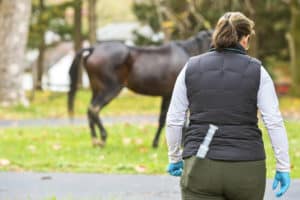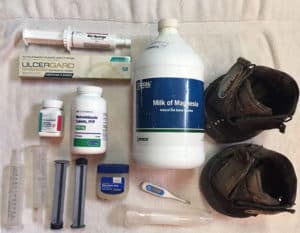Making Strides
- Topics: Horse Sense (and Sensibility)
“Oh, you again,” the big gray gelding’s eyes seemed to say with a huge sigh of resignation. I was retrieving Bacchus, a mellow, retired Belgian/Quarter Horse-cross gelding, from his paddock for a session of his twice-daily therapy–the old guy had a reinjured tendon, and we followed a morning and evening ritual of retrieving, tying to hitching post, cold-hosing the bow, drying off leg, applying medication to areas of dew poisoning from the wet-dry-wet-dry posed by hosing over the prior weeks, and turning back out. I’ll admit, it was a bit tiresome for both of us, but this horse was practically sainted, and his owners wanted this former foxhunter and general all-around packer pasture sound and comfortable. As I had happily piloted him many times in his sound years, I was also on board with this plan, so our twice-a-day routine was well worth the trouble.
What’s amazing to me is how far tendon (and ligament) diagnostic and treatment techniques have come in just the few short years since Bacchus’ treatment regimen.
For quite a while now veterinarians of high-performance horses have employed diagnostic ultrasound for these types of injuries, and these clinicians continue to progress in their use of this and other diagnostic imaging methods (MRI, etc.). (I’m always amazed by what can be seen in terms of tendon fiber alignment, etc., on that little ultrasound screen!) Over time, top vets have adopted their preferred surgical and mechanical approaches to treatment (also described in our June issue cover story–beginning on page 20). And extracorporeal shock wave therapy has seemingly gone mainstream over the past 10 years.
Regenerative medicine came onto the scene in more recent years. Vets, owners, and the popular press are discussing this subject, so it’s important we provide some insight on what researchers are saying. As with many other equine veterinary issues, there are distinct sides: One side is utilizing the technology daily and promoting its usefulness. Another side is tapping the brakes, reminding vets to be critical of treatment that isn’t backed by many years of peer-reviewed, published research. Yet a third side (which may also contain members of the prior two groups) is examining efficacy/applications through research
Create a free account with TheHorse.com to view this content.
TheHorse.com is home to thousands of free articles about horse health care. In order to access some of our exclusive free content, you must be signed into TheHorse.com.
Start your free account today!
Already have an account?
and continue reading.

Written by:
Stephanie L. Church, Editorial Director
Related Articles
Stay on top of the most recent Horse Health news with














